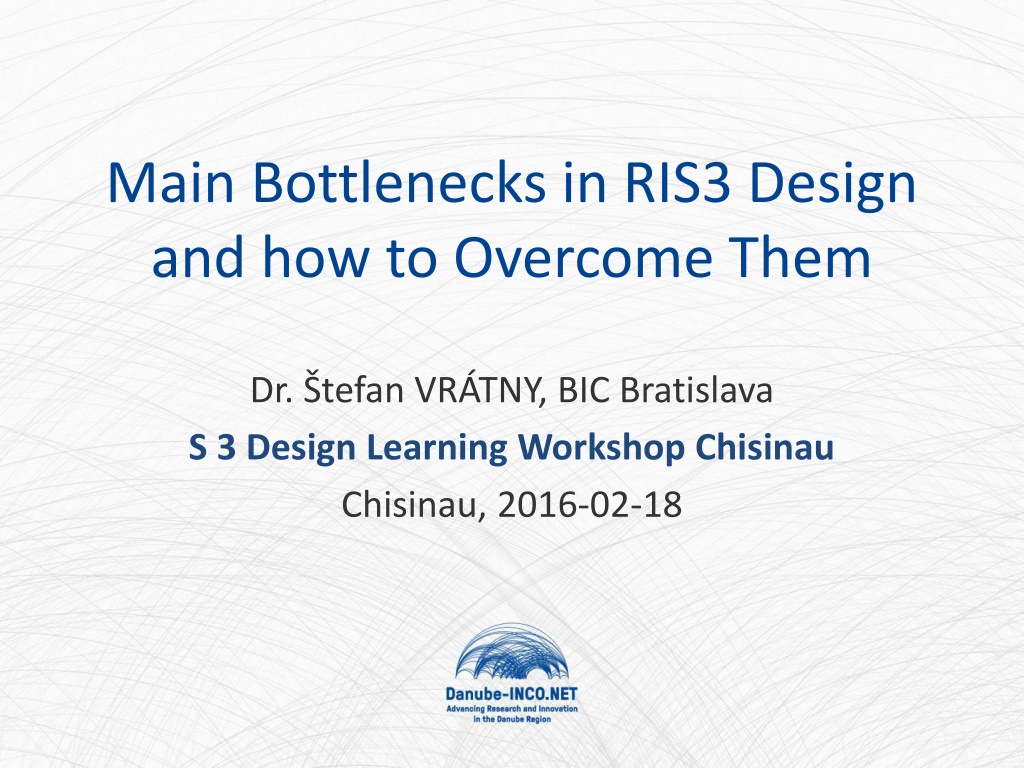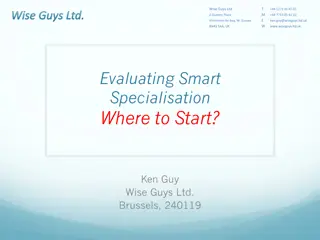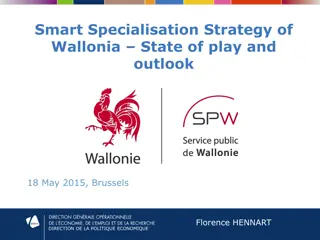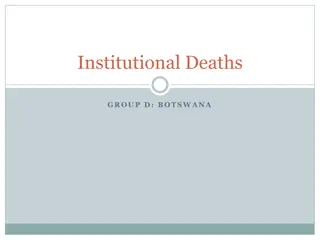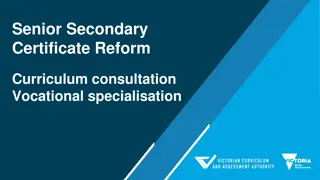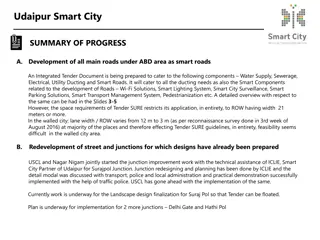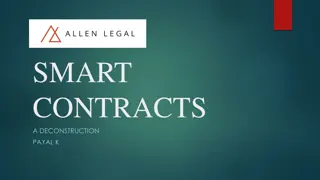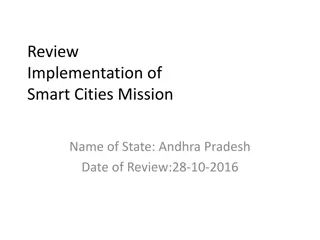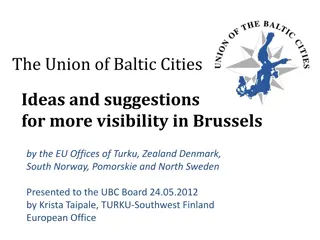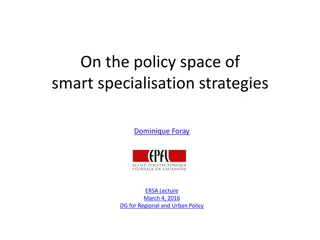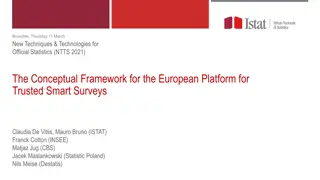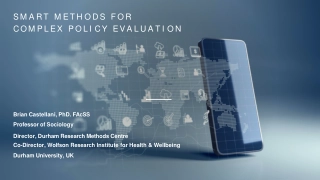Addressing Main Bottlenecks in RIS3 Design for Smart Specialisation Strategies
The presentation explores the challenges faced in designing RIS3 strategies, focusing on Slovakia's development and implementation. Key bottlenecks include misunderstanding the economic ecosystem, overlooking stakeholder involvement, and more. Insights on overcoming these obstacles are shared, drawing from Slovak experiences and discussions on fostering innovation and growth in strategic sectors.
Download Presentation

Please find below an Image/Link to download the presentation.
The content on the website is provided AS IS for your information and personal use only. It may not be sold, licensed, or shared on other websites without obtaining consent from the author. Download presentation by click this link. If you encounter any issues during the download, it is possible that the publisher has removed the file from their server.
E N D
Presentation Transcript
Main Bottlenecks in RIS3 Design and how to Overcome Them Dr. tefan VR TNY, BIC Bratislava S 3 Design Learning Workshop Chisinau Chisinau, 2016-02-18
Content 1. General Situation and RIS 3 Development and Implementation in Slovakia 2. Main bottlenecks in Designing the RIS 3 S 3 (Smart Specialisation strategy) 3. The ways to overcome the bottlenecks within RIS 3 Design Process 4. Slovak experience 5. Questions and Discussion
1. General Situation and RIS 3 Development and Implementation in Slovakia (1) The Slovak republic was established in 1993 as a follower of the Czech and Slovak Federal Republic Member of V4 (1993), OECD (2000), EU (2004), Eurozone (2009) Population: 5, 4 million, 49 000 km2, GDP per cap. 29200 USD in 2014 (source IMF, rank 40 worldwide, rank 18 in the EU, 77 % of EU average compared to 56 % in 2004), Bratislava region 53 400 USD (49000 , among the top 10 EU regions), GDP growth in 2015 3,7 % (30 300 USD per cap.)
1. General Situation and RIS 3 Development and Implementation in Slovakia (2) Fast growing, high industrialized economy, e.g. 3 automotive manufacturers (1 million cars production in 2015, prognosis 1,4 million in 2020), the 4th automotive producer under construction, the fifth one under negation. Electro-technical, metallurgy and fast growing IT industry - 50 000 IT experts. Service sector and agrofood
1. General Situation and RIS 3 Development and Implementation in Slovakia (3) BIC Bratislava, established in 1991, the Enterprise Europe Network coordinator in Slovakia, working for the EC, SK government governments, involved in RIS 3 development in the Bratislava region (2012) and in the Slovak RIS 3 (2013), evaluating other developing a Framework to S 3 in agrofood sector in Slovakia (2015) and regional EU/non EU regions,
2. Main bottlenecks in Designing the RIS 3 S 3 (Smart Specialisation Strategy) (1) Misunderstanding the economic and social ecosystem of the country/region Wrong understanding of the S 3 as a Research and Development Strategy Underestimating or misunderstanding of the Entrepreneurial discovery process Not considering the main stake holders, especially form the industrial and economic sector
2. Main bottlenecks in Designing the RIS 3 S 3 (Smart Specialisation strategy) (2) Missing the overall vision of the future economic and social development of the respective region/country Not smart the S 3 will be designed without a proper and evidence based analysis of the regional economy and potential for innovation, using wrong methodology and approach Not specialised too many sectors are being selected and thus no effects form specialisation can be reached, the country/regional strength advantages will not be properly identified, priorities identification and competitive wrong
2. Main bottlenecks in Designing the RIS 3 S 3 (Smart Specialisation strategy) (3) No processes and resource planning in order to achieve the defined goals and the RIS 3 methodology is not considered Wrong identification of leadership structure Wrong or even no definition of roadmaps and action plan no proper implementation mechanisms Missing or insufficient monitoring and evaluation mechanisms strategy the comprehensive system of the governance and
3. The ways to overcome the bottlenecks within RIS 3 Design Process (1) Right ecosystem, performance, banking system, quality of HR and labour force, governance, enforcement of law, efficiency of public administration, bureaucratic burden, corruption, etc. S 3 is more than Research and development strategy, it is focusing of competitiveness economy through enhancement of relevant economic sectors (industrial, agrofood, services). SK experience: R&D&I strategy was developed instead of a S 3 one. Restarting the work again understanding of e.g. the economic entrepreneurial and social innovation and increase of national
3. The ways to overcome the bottlenecks within RIS 3 Design Process (2) Strong consideration of entrepreneurial environment and its dynamics, identification of obstacles and needs, incl. R&D and Innovation, grow potential and competitiveness Involvement of stake holders, incl. entrepreneurial players and governance bodies, e.g. industrial associations, clusters, R&D actors, universities and education providers, research, economy and financial ministries, governmental office, etc.
3. The ways to overcome the bottlenecks within RIS 3 Design Process (3) Generation of the general vision of the development of national economy over next time period - 5 to 10 years in terms of main sectors, competitiveness and benchmarking with other countries/regions Using S 3 methodology, exploitation of experiences gained, using foreign experience Deduct and identify the main economic sectors with the most growth potential and relevancy for the national economy, prioritise and specialise, do not choose too much sectors, identify clear priorities experts positive SK
3. The ways to overcome the bottlenecks within RIS 3 Design Process (4) Develop a consist, ambitious, however realistic strategy defining the use of limited resources in order to develop the selected sectors to high regional/international competitiveness Think about the implementation of the S 3, identify and ensure the right governance and leadership structure, e.g. office of the government who will implement the S 3 Define realistic roadmaps and action plans how the S 3 and in which ways the S 3 will be implemented
3. The ways to overcome the bottlenecks within RIS 3 Design Process (5) Measure the progress during the S3 implementation, monitor, define and solve the deviations, evaluate the progress S3 implementation is an open and interactive progress, ensure the ongoing dialogue between the main stake holders, governance structures and implementing bodies. Revise if necessary
4. Slovak experience (1) Fast development and approval (by SK government) of the S 3 (as the ex ante condition for the ESIF OP R&I) but no action plan after more than two years after the S 3 approval, EC criticism of the OP R&I because of the low consistency with the S 3 Though the S 3 is the best document for the Strategy development of the national economy until 2020
4. Slovak experience (2) Definition of: 4 main industrial sectors: automotive, IT, E-technics, metallurgy 3 main R&D sectors: advanced materials (light construction materials (security SW), medicine biotech (fast diagnostics methods) KIBS Knowledge intensive development for car production), IT business services
4. Slovak experience (3) Definition of: Agriculture, environment, energy development Human resources development and education Horizontal goals and measures, e. g. increase of added value, of R&D performance, development mechanisms, tax incentives for R&D expenditures, etc. expenditures, of of financial SME proper
5. Questions and Discussion Dr. tefan Vr tny BIC Bratislava vratny@bic.sk Thank you for your attention!
